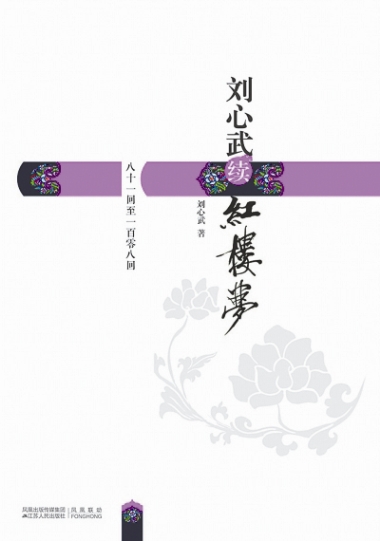
Cao Zhen
AFTER two decades as a researcher of the Chinese classical novel “A Dream of Red Mansions,” it is not surprising that Liu Xinwu is ready for something more challenging. He has finished rewriting the ending of the classic and will release it in April.
The acclaimed author, 69, took seven years to write his 28-chapter ending to replace the original 40-chapter ending to one of China’s greatest literary works.
“The 40-chapter ending has misled Chinese readers for more than 200 years,” said Liu. “Rewriting the new ending was the last desire of my life.”
The Beijing Fonghong Media Co. Ltd. has released the chapter titles of Liu’s work on its blog and some texts have been leaked online. Supporters say Liu’s courage and years of elaboration are respectable, and his writing will be a literary feat of 2011. Die-hard fans of the original book treat Liu’s work as a wretched sequel that could ruin the exquisite original.
“A Dream of Red Mansions,” also known as “Dream of the Red Chamber” or “The Story of the Stone,” was mainly written by Cao Xueqin in the middle of the 18th century during the Qing Dynasty. The 120-chapter book is acclaimed as one of China’s Four Great Classical Novels for its complex plot and smart use of puns. It is a masterpiece of Chinese vernacular literature and is generally acknowledged to be the pinnacle of classical Chinese novels.
“Red Mansions” is believed to be semi-autobiographical, mirroring the ups and downs of author Cao’s own family, which had a close relationship with the royal reign. But, to protect himself, Cao says in the first chapter that the book is only a memorial to the women he knew in his youth.
It is generally agreed that Cao finished the first 80 chapters and the last 40 chapters were written by Gao E, a Qing Dynasty scholar. Cao did not live to see the novel published, and only the hand-written 80-chapter manuscript survived after his death. In 1791, the first printed version was published by book dealer Cheng Wenyuan and Gao E. Most scholars believe the printed 120-chapter version contains edits and revisions not authorized by Cao.
Meanwhile, in the hand-written 80-chapter version, comments and annotations in red ink were marked by ancient unknown commentators. These remarks reveal much about the background of Cao’s family and the novel’s ending.
The most prominent commentator is Zhiyanzhai, or Rouge Inkstone, who revealed much of the interior structuring of the work and the original manuscript ending, now lost.
Most modern researchers, including Liu, use the first 80 chapters and Rouge’s remarks as text analysis because the early 80 chapters brim with prophecies and dramatic foreshadowing which also give hints as to how the book would continue. From the early 1900s to the present, there has been much critical scrutiny, debate and conjecture of the “Red Mansions” ending.
Liu believes that Cao did finish the whole novel, a total of 108 chapters, and Cao’s later 28 chapters were missing. Based on his text analysis, early scholars’ research and his investigative studies of Cao’s family history, Liu concludes that the major characters’ fate in Cao’s later 28 chapters are totally different from Gao’s 40-chapter ending and Liu believes his new ending will be closest to Cao’s.
Liu, who is known for his satirical tone in short stories in the late 1970s and 1980s, stirred the country’s “Red Mansions” research circle in 2006 when he gave lectures on popular lunchtime program “Lecture Room” on China Central TV (CCTV).
Although some of Liu’s research is based on the work of earlier scholars, including Hu Shi and Zhou Ruchang, Liu’s bold conjecture of Cao’s ending and relentless attack on Gao’s ending sparked hot debate among critics and bibliophiles.
“Some people want me to present my evidence. My major evidence is the book itself,” said Liu in 2006. The modest writer holds the classic in awe, saying he does not dare to claim that he fully understands every detail of the masterpiece. He even regretted in 2006 that if he had known there would be controversy, he would never have appeared on CCTV.
However, from 2006 to last year, Liu continued to appear on “Lecture Room,” publicizing his latest research on “Red Mansions.” In the meantime, other critics also gave lectures on TV, elaborating on their research from different perspectives.
“I still believe Cao’s later 28 chapters were finished and must be somewhere in the world today,” Liu said on “Lecture Room.” “It is a pity that the book we have is incomplete, but this incomplete work has me obsessed.”
During the past two decades, Liu has published a string of essays and short stories on his studies of the “Red Mansions.” Different from his previous short stories, which use modern Chinese, his 28-chapter ending will use Cao’s style of language. But, for the convenience of modern readers, Liu will use simplified Chinese characters rather than Cao’s traditional Chinese.
Some critics refused to comment on Liu’s efforts. Some book enthusiasts say writing essays is different from rewriting the ending for the novel and they don’t want anyone to add arms to “Venus de Milo.”
|

